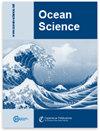巴拿马湾季节和El Niño-Southern振荡相关的海洋变率
IF 3.3
3区 地球科学
Q2 METEOROLOGY & ATMOSPHERIC SCIENCES
引用次数: 0
摘要
摘要在巴拿马湾,从27年的绝对动力地形(ADT)和使用自组织地图观察到,两种不同的季节性地表环流模式与强烈的平均海平面变化相吻合。从1月到4月,巴拿马地表风急流的强迫作用下,一个具有强烈西南向巴拿马急流表面流(PJSC)的气旋环流主导了盆地环流,该环流也产生上升流,降低了海温(SST),增加了海表盐度(SSS),导致adt下降。从6月到12月,Choco地面风急流增强了海温、降水和河流径流,减少了SSS,引起ADT上升,而ADT上升又迫使夜间弱环流,使PJSC消失。该地区年际变率受El Niño-Southern涛动(ENSO)的强烈影响;然而,这种气候变化并没有改变巴拿马湾的季节性环流模式。相反,正(负)ENSO相位增加(减少)巴拿马湾的海温和ADT,两者的年平均差异分别为0.9°C和9.6 cm,而对SSS的影响较小。然而,由于强烈的季节海温、SST和ADT的变化幅度可达2.2°C、2.59 g kg−1和28.3 cm,因此季节信号在亮度的年际变化中占主导地位。本文章由计算机程序翻译,如有差异,请以英文原文为准。
Seasonal and El Niño–Southern Oscillation-related ocean variability in the Panama Bight
Abstract. In the Panama Bight, two different seasonal surface circulation patterns
coincide with a strong mean sea level variation, as observed from 27 years
of absolute dynamic topography (ADT) and the use of self-organizing maps.
From January to April, a cyclonic gyre with a strong southwestward Panama
Jet Surface Current (PJSC) dominates the basin circulation, forced by the
Panama surface wind jet that also produces upwelling, reducing sea surface
temperature (SST), increasing sea surface salinity (SSS) and causing an ADT
decrease. From June to December, the Choco surface wind jet enhances SST,
precipitation and river runoff, which reduces SSS, causing an ADT rise, which in turn forces a weak circulation in the bight, vanishing the PJSC. Interannual
variability in the region is strongly affected by El Niño–Southern Oscillation (ENSO); however this
climatic variability does not modify the seasonal circulation patterns in
the Panama Bight. In contrast, the positive (negative) ENSO phase increases
(decreases) SST and ADT in the Panama Bight, with a mean annual difference
of 0.9 ∘C and 9.6 cm, respectively, between the two conditions,
while its effect on SSS is small. However, as the strong seasonal SST, SSS
and ADT ranges are up to 2.2 ∘C, 2.59 g kg−1 and 28.3 cm,
the seasonal signal dominates over interannual variations in the bight.
求助全文
通过发布文献求助,成功后即可免费获取论文全文。
去求助
来源期刊

Ocean Science
地学-海洋学
CiteScore
5.90
自引率
6.20%
发文量
78
审稿时长
6-12 weeks
期刊介绍:
Ocean Science (OS) is a not-for-profit international open-access scientific journal dedicated to the publication and discussion of research articles, short communications, and review papers on all aspects of ocean science: experimental, theoretical, and laboratory. The primary objective is to publish a very high-quality scientific journal with free Internet-based access for researchers and other interested people throughout the world.
Electronic submission of articles is used to keep publication costs to a minimum. The costs will be covered by a moderate per-page charge paid by the authors. The peer-review process also makes use of the Internet. It includes an 8-week online discussion period with the original submitted manuscript and all comments. If accepted, the final revised paper will be published online.
Ocean Science covers the following fields: ocean physics (i.e. ocean structure, circulation, tides, and internal waves); ocean chemistry; biological oceanography; air–sea interactions; ocean models – physical, chemical, biological, and biochemical; coastal and shelf edge processes; paleooceanography.
 求助内容:
求助内容: 应助结果提醒方式:
应助结果提醒方式:


